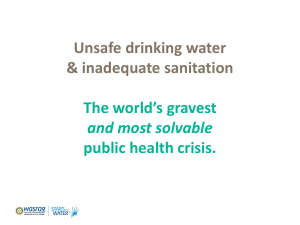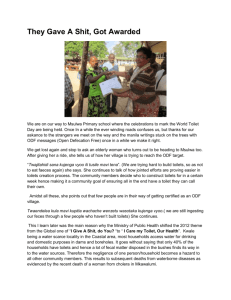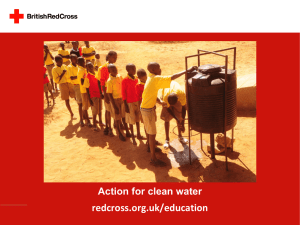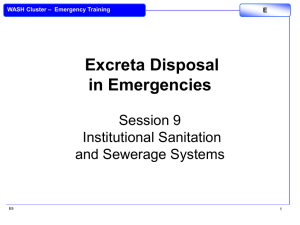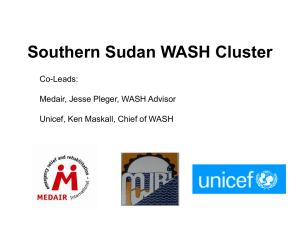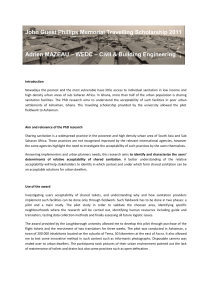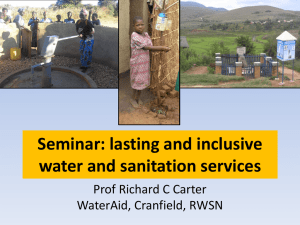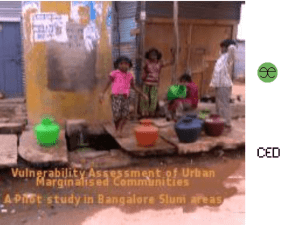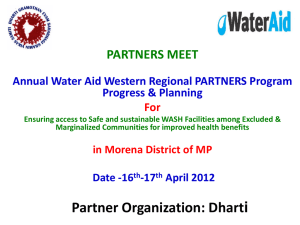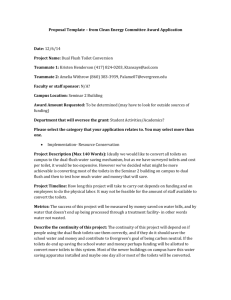Document 5805675
advertisement
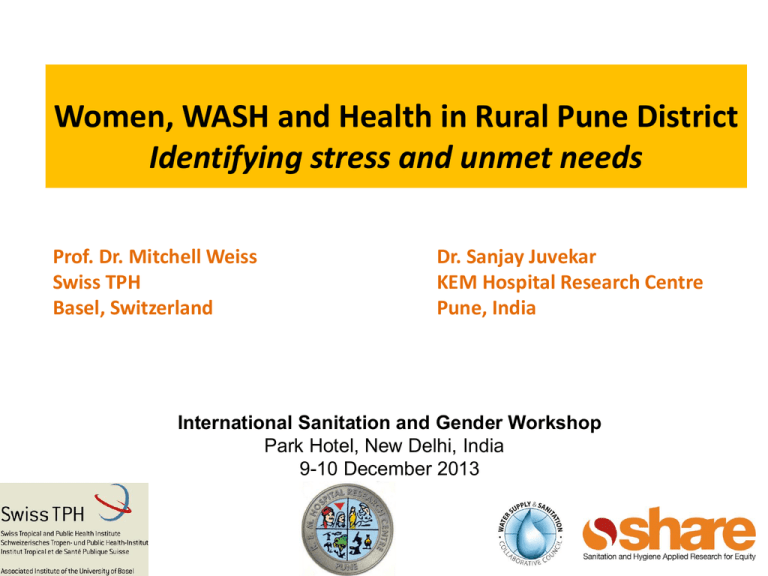
Women, WASH and Health in Rural Pune District Identifying stress and unmet needs Prof. Dr. Mitchell Weiss Swiss TPH Basel, Switzerland Dr. Sanjay Juvekar KEM Hospital Research Centre Pune, India International Sanitation and Gender Workshop Park Hotel, New Delhi, India 9-10 December 2013 Too few toilets for too many people Indicated failure to apply expertise • Household coverage with cell phones 59% compared with 47% with toilets (Census 2011) • Many schools fail to comply with requirements for toilets • Medical facilities lack adequate sanitation facilities • Mission Mars landing: contradiction between high-tech capacity and limited attention to basic needs, incl. sanitation Well-known and widely reported The Hindu, Chennai, 14 Mar 2013. See also, Chambers R and von Medeazza G. Sanitation and stunting in India: undernutrition’s blind spot. Econ Pol Weekly 22 Jun 2013. Health and Gender-related impact Health • Diarrheal diseases • Stunting • Psychosocial stress from limited (access to) facilities Gender-related • Vulnerability to violence and victimization • Cultural meaning and social restrictions of menstruation • Burden of culturally mandated modesty Coping Problematic • Avoiding hydration and solid foods • Acceptance of unacceptable status quo Constructive • Clarify the nature and extent of communityperceived burden • Replace victim blame and shame with social change • Advocacy and support Request for Proposals : The effects of poor sanitation on women and girls in India Response Collaboration between: KEM Hospital Research Centre Pune’s field site Vadu Rural Health Program in India (KEMHRC) and Swiss Tropical and Public Health Institute, Basel, Switzerland (Swiss TPH) 8 Conceptual framework of research plan Basic needs Facilities and resources Usemitigating factors Practice Health impact • Defecation-urination • Nutrition-hydration • Menstruation • Toilets and fields • Water and food • Absorbent materials • Personal prior experience • Family and community experience and expectations • Social and cultural values • WASH-related behaviour • Indicated adjustments to dietary and fluid intake • Menstrual hygiene • Self-perceived health problems or benefits of reported practice • Psychosocial effects: personal, family and community Aims 1. 2. 3. 4. Identify sources of psychosocial stress with reference to personal experience, reported accounts and perceived vulnerability to violence that affect access and use of various types of sanitation facilities and open defecation. Identify women’s preferences, priorities, practices and perceived needs regarding menstrual hygiene, distinguishing preferred and available options, assessing the stress imposed by social expectations and cultural values and clarifying perceived effects on women’s health. Assess the level of stress, priority and self-perceived effects of limited access to water and sanitary facilities, and the extent to which such concerns may lead to coping strategies that involve limiting intake of food and liquids. Determine the availability, functionality and perceived adequacy of sanitary infrastructure in local health facilities, with particular attention to those facilities providing prenatal and obstetric care. Clarify whether these concerns influence the preference and use of accessible health facilities. Methods No. Research Method 1. 2. Sample Quantitative Research Survey questionnaire a. 150 adolescents (13-17 years) b. 150 adults (18-45 years) Health facility infrastructure assessment 12 health facilities in the study area (public as well as private) Qualitative Research a. Focus group discussions 8 to 12 Focus Group Discussions(2 each of adolescents, young women, older women and seasonal migrant women) b. Key informant interview 10 Key Informants Interview (2 each of Members of Gram Panchayat, Members of Panchayat Samiti, School Teachers, Health Professionals like ASHA, ANM and Medical officers). c. Free listing a. 20 adolescents (13-17 years) b. 20 adults (18-45 years) Data analysis: qualitative Collected through FGDs, KIIs and Free listing: • Transcription and translation of recordings • First-level coding • Analysis using standard qualitative analysis approaches and programmes (e.g. MAXQDA or Altas.ti and Anthropac) • Analysis of the free listing exercise with reference to the cultural domains they refer to, including WASH-related and menstruationrelated issues Data analysis: quantitative Collected through community survey and WASH infrastructure in health facilities survey • Summarizing data with standard descriptive statistical measures such as means, median and standard deviations. • Statistically significant associations using standard statistical tests such as Pearson’s chi-square test and t-tests, as appropriate. • Multivariate models to identify the most important determinants of certain outcomes while considering known and suspected explanatory and confounding variables. • Using STATA statistical package Work done so far • Study Inception workshop in September 2013 to finalize the protocol and data collection tools • Ethics committee approval obtained – KEMHRC and SwissTPH • Tool field pretesting in November 2013 • Training of field team in end of November 2013 • Field data collection started 2nd December 2013. Preliminary experiences Observations: • Migrants and local residents have differential access to facilities. • Snake bite is reported in response to questions about violence. • Generally people do not report violence (could be reality / could be shame) Quotes: Pretesting- FGD • “We observe the restrictions during menstruation and we would want the next generation to observe the same”. • “The Goddess is very strict, hence it is important that restrictions are observed during menstruation” • “We are migrants, so they (the politicians) think that we need only shelter and water but no one thinks about toilets”. • “We have everything (toilet facility) at home but at public places we need toilets”. Quotes: Pretesting- KII (Local body leader) • “In our village things like this (violence) do not take place but I have heard such incidences from outside”. • “Funds are insufficient for maintaining the toilets at schools and public places”. Expected impact A) Locally (in Vadu): 1. Documentation of stress and unmet needs related to WASH 2. Evidence to inform policy, public investments and programmes. B) Nationally (in the framework of the larger SHARE and WSSCC objectives): 1. Contribution to national data on demand for WASH and psycho-social effects of current deficits. 2. Baseline to benchmark impact of future sanitation and violenceprevention programs. 3. Identification of factors hindering success of existing programs (focus on WASH, menstrual hygiene, utilization of health care facilities and school attendance). One-page factsheet and other materials focusing on safe and gender sensitive WASH solutions for scientific community, local government bodies as well as the study population Intersectoral collaboration • • • • Social Engineering Medical Development Vulnerabilities • • • • Gender Physical disability and special needs Stage of life Poverty and capacity to cope Interpreting limited opportunities for sanitation Blame victim Change social system Cultural pollution Morality and purity Social basis of burden Public health and human rights Motivation of research and how we use evidence • Advocacy – Elaborate problems and need for solutions – Budget – Specific programme strategy • Guidance – Analysis of problems and ways to mitigate – Design of intersectoral solution (e.g., facilities, policies) – Specific strategies: implementation and training Thank you
